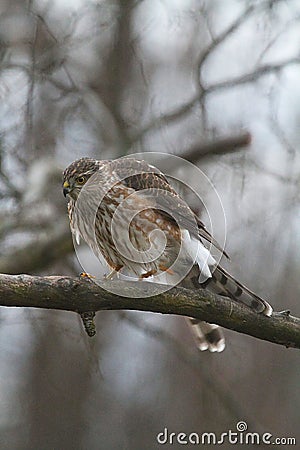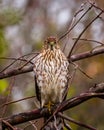Designed by
Title
Juvenile Cooper's Hawk on Tree Branch Feathers Fluffed Out 2 - Accipiter cooperii #299359228
Description
Cooper's hawk (Accipiter cooperii) is a medium-sized hawk native to the North American continent and found from southern Canada to Mexico. Juveniles of the species are generally dark brown above, though the feathers are not infrequently edged with rufous to cinnamon and have a variable whitish mottling about the back, wing coverts and, mainly, the scapulars. Juvenile Cooper's tend to have streaking or washing of tawny on the cheeks, ending in a light nuchal strip, giving them a hooded appearance unlike the capped appearance of adults. The crown is brown on juveniles rather than blackish as in adults. The tail is similar to that of the adult but more brownish and sometimes shows an additional fourth band. The juvenile has more pale white to cream base color showing than older birds, with variable dusky throat striping and mid-brown streaks, which appear as sharply defined from about the lower throat to the lower breast. This species is a member of the genus Accipiter, sometimes referred to as true hawks, which are famously agile, relatively small hawks common to wooded habitats around the world and also the most diverse of all diurnal raptor genera. Cooper's hawks prefer to nest in tall trees with extensive canopy cover and can commonly produce up to two to four fledglings depending on conditions. Cooper's hawk is a medium-sized hawk and largish for an Accipiter. Compared to related species, they tend to have moderate-length wings, a long, often graduated or even wedge-shaped tail and long though fairly thick legs and toes. Their eyes tend to be set well forward in the sides of the relatively large and squarish-looking head (though the head can look somewhat rounded if the feathers on the nape are held flush) and a relatively short but robust bill.

















